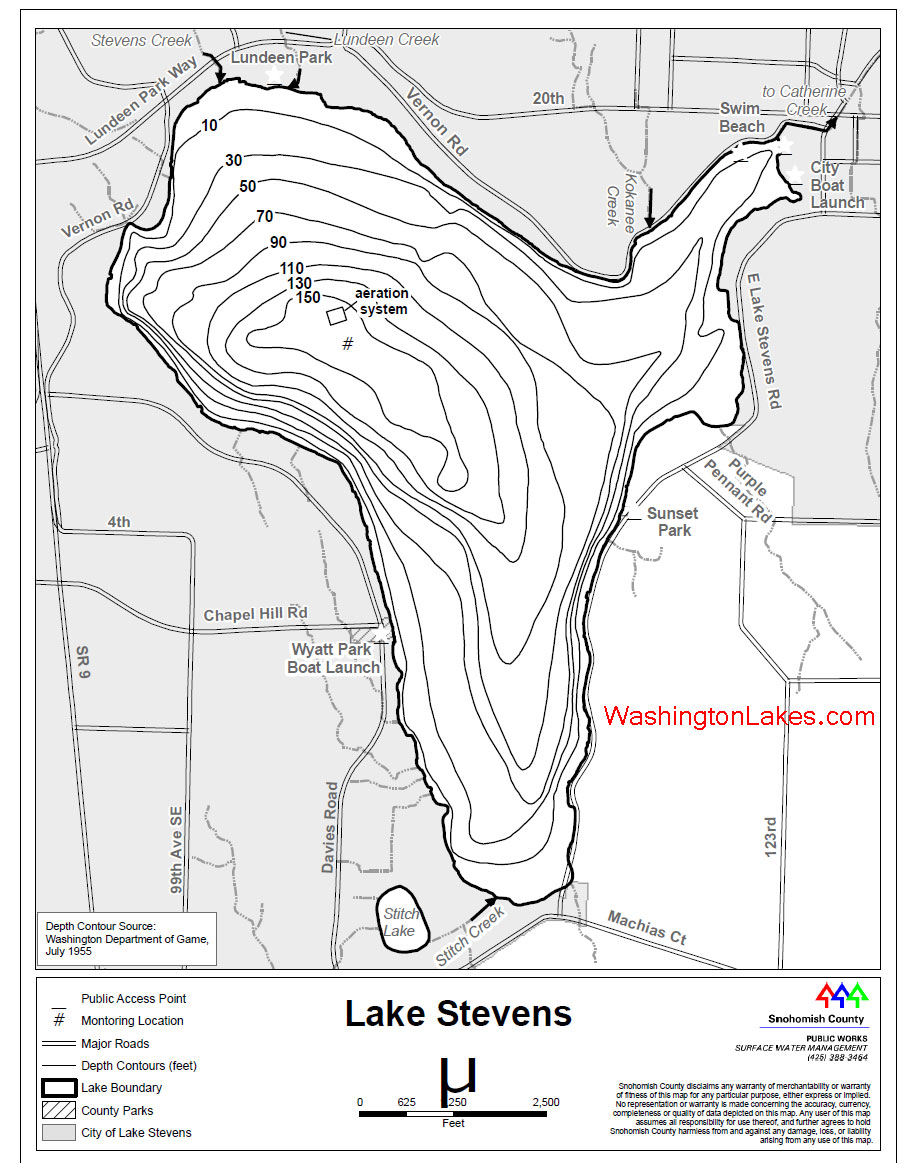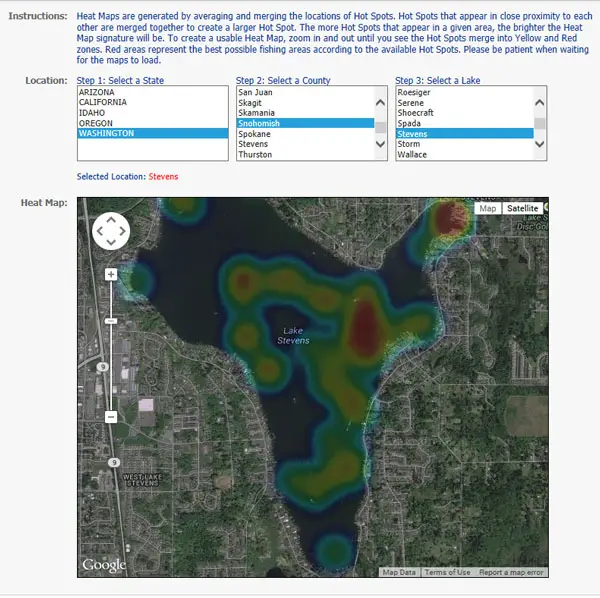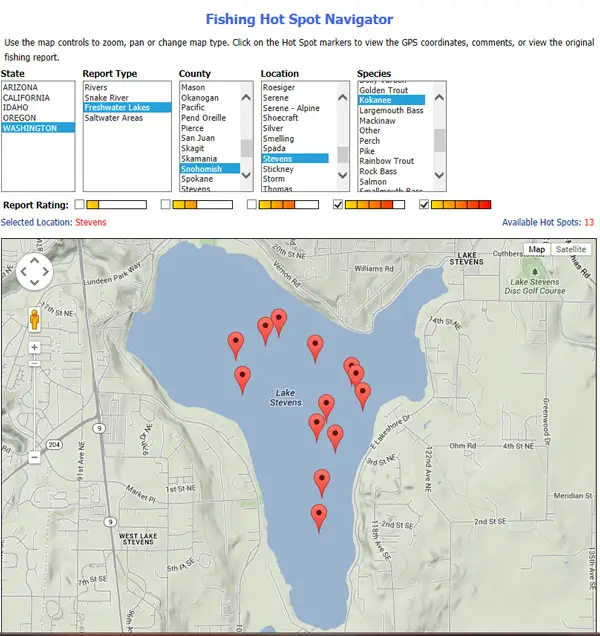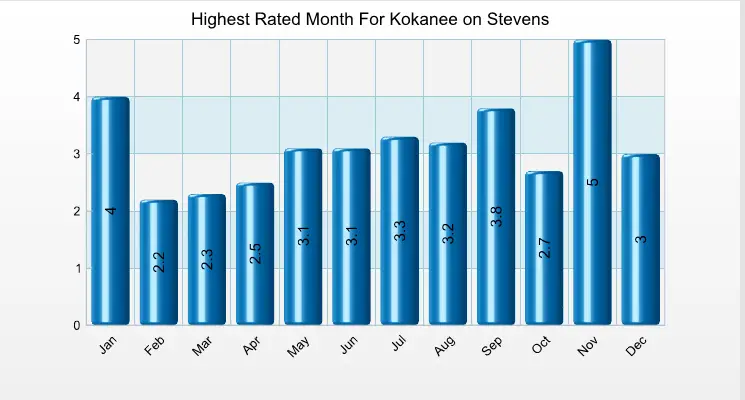Search
Latest Articles
Lake Stevens Spring Kokanee Fishery
by Mike Carey, April 28, 2014
The lake has two primary boat launches. On the east side, off 17th Place NE is the Lake Stevens City Boat Launch. This launch is a WFDW access launch so if you have your Access Pass you are good to go, no cost. The launch itself is not the greatest. The ramp has a funky tilt and angle to it which makes it challenging to load your boat back up. There are two lanes, the second is gravel. In addition, this is a popular place for the rowing crews to meet and launch at so there is that traffic. There is an adequate pier and parking, on weekends it fills up. The second launch is the county boat launch on the west side of the lake, Willard Wyatt Park off S. Davies and Chapel Hill Road. It has a first rate two lane ramp and pier. However, there is limited space to turn around and the trailer parking is across the street. Sixteen trailer spots so get there early. There is a public swim area so you’ll find lot’s kids running around and behind your backing trailer. Proceed with caution! The parking and launch is a pay area.
OK, so you’ve got your boat in the water – you did go early, right?
Lake Stevens kokanee love that early morning bite. Not to say you won’t catch fish all day and into the evening, but having your lines in the water as the sun first comes up is really important on this lake. And, as Russell Wilson is so fond of saying, “preparation equals separation”. What will set you apart from other anglers is to have everything ready to go ahead of time. That means your bait has been prepped and is curing, your rods are set up, and all equipment is checked and in working order. Oh, and your cooler is full of ice. Let’s take good care of those fish!
Timing is everything, not just time of day, but also time of year. As you can see from the chart on historical catch trends from WashingtonLakes.com readers, the transition period on Lake Stevens begins from April into May, and steadily improves through the summer. The lake is stocked with spring fry kokanee by WDFW. These fish are planted at 2-8” and 150,032 were planted in May-June of 2011. These fish are grown and available now. 182,800 were planted in May of 2012. These fish will be catchable in the fall of 2014 (per WDFW stocking report).
OK, let’s talk about location (location, location).
Kokanee are generally a schooling fish, and were you find one you’ll often find more. That said, fish also tend to hold in predictable areas. Or maybe anglers tend to fish in predictable areas. So while it’s useful to know locations and “hotspots”, it’s important to be willing to move around, explore, and try different spots away from the crowds. I have my favorite locations to hit first and you’ll develop your own as you fish and learn the lake. I also bring my hand held GPS unit along, and when I catch a kokanee I will mark the location. As the years go by this gives my patterns and spots to target, making this 1,000 acre lake a little bit smaller. Another nice resource is our Digital Anglers Premium Membership features “Hotspots” and “Heat Map”.
The hotspots can be downloaded to your computer and transferred to your GPS. You can also just print out either map for a visual hint of places to fish. Of course, following others around never hurts, either, but don’t be afraid to explore new spots. Oh, and while you’re at it, download and print out a depth map. When trolling you need to know ledges and holes to target. There’s nothing worse than having a downrigger at 70 feet and having the depth suddenly shallow out to fifty feet. So let’s take a look at our maps and try to figure out some patterns.
First, the depth contours. As you can see, the lake is pretty uniform in its contour lines. Generally working from the center aeration system out the lake gradually shallows up. The except to this is the south arm of the lake, where the west shoreline shallows out farther off shore, and the northeast arm, which again has a long flat of 30-50 feet deep. Spring fishing for kokanee tends to be a shallow water fishery, so this gives you more areas of the lake to check out. But as summer progresses and the lake warms, you’ll be doing deeper trolling, down to 60-90 feet, and the lake “shrinks”. By the way, there is one thing you won’t see on a contour map but need to be aware of. North of the aerator there is a cable that runs out approximately 50-75 yards to a buoy. If you troll east-west between the buoy and the aerator be prepared to have your downrigger ball get caught. Proceed with caution when trolling the aerator area.
Our next map is called a Heat Map. This map is a visual representation of our readers fishing report ratings, converted into “hot” zones. It’s useful for general trends and areas. You can use the Heat Map tool on the site to zoom in and out for greater detail. As you can see from this map, there is a distinct pattern and areas for you to check out first when you fish Lake Stevens. The area just outside the east bay is particularly interesting.
Finally, the Crowning Jewel of our member maps, Hotspots. Hotspots are specific locations that members have marked on their fishing reports as locations they had good luck at. Taken as a whole, they again provide new anglers with specific locations to check out. Hotspots can be downloaded to your GPS, or you can print out the map. In this example map, I’ve used the filtering tool above the map to display only kokanee hot spots, and further limited the map to only “4” and “5” star hotspots. A pattern is now emerging for you to focus your attention on.
We’ve reviewed information about the lake and times/locations to fish. How about techniques? I’m a trolling angler when it comes to kokanee, so I’ll focus on a few techniques for you to consider. Over the years I have not heard/read a lot about still fishing or casting to Lake Steven’s kokanee, but I know those are options. As for me, trolling is my comfort zone.
To start off, do you have a two rod endorsement? If you don’t, I encourage you to get it. Especially when fishing solo, having that second line running can make a big difference. When it comes to kokanee fishing, you’ll find at times that the biting fish may run in certain water depths. So you can be marking fish on your fish finder, but they won’t bite a thing you throw at them. Meanwhile fish at the other depth are ready and willing. Unfortunately, by the time you switch and work this second group of fish, they are off the bite. Having two rods simple allows you to cover more territory. So if two is good, is four better? Some school of thought would say no, that the sling blades and dodgers you’re running will over-whelm the fish and make them less aggressive. I don’t subscribe to that theory and will run as many rods as the boat is allowed and I and my guests can handle. I like to stagger my gear at around 15 feet on each downrigger and use this staggering to fish throughout the water column. So at lake Stevens in the spring when the kokanee are not as deep, if I have four rods running I’ll stack on the starboard side at say 10 and 25 feet, and on the port side at 20 and 35 feet. So separation and spacing occurs on my lines. I’ll then make my adjustments depending on what I’m seeing on the fish finder. The other thing I am running routinely now is the Mack’s Double D small dodgers on my shallow lines. Why? The Mack dodgers have settings that allow them to run out and away from the boat. Since I’ve been running them my tangle rate has gone to zero. And zero tangles mean more fishing time and more fish.
As to what’s on the working end of the rod, there is a huge assortment of wedding rings, flies, and squid rigs out on the market today. Most of it is very good and all are likely to catch a hungry kokanee on the bite. So I’ll leave it to you to decide just what you want to run. I would suggest that if you’re not getting bit it’s time to change it up. I generally give my gear 30-45 minutes and then have another terminal lure ready to go. I’ll have it all baited up and simple remove the old and add the new set up. Always think of ways to maximize the time your lures are in the water fishing. Its little things that can make the difference when kokanee fishing.
Lastly, when fishing new water a trip with a guide can give you some great insider knowledge on the water and techniques that work best. A good local guide that knows Lake Stevens like the back of his hand is Zack McGlothern of NorthwestSportfishing (www.norwestsportfishing.com) (360) 722-4843. Check out his web site for current deals and how the lake is fishing.



